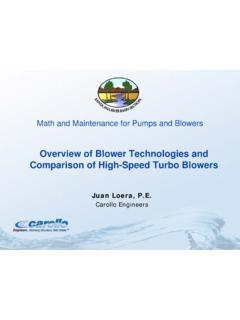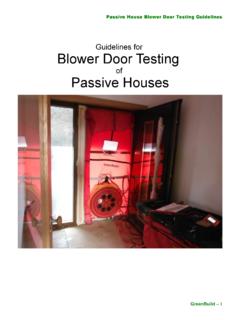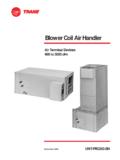Transcription of BE-3517 color new - Blower Engineering Inc.
1 PageCustomer Letter/ Warranty .. Scope .. Operating principle .. Construction .. Gas conveyed .. Working conditions .. Speed of Capacity adjustment .. Handling .. Storage .. Bearing Preservation of the compression On-site positioning of Blower .. Changing the inlet/outlet arrangement .. Coupling .. Direct Belt drive Direction of rotation air flow direction .. System piping .. Inlet Outlet Check valve .. Safety valve .. Electrical connection .. Preliminary controls .. Start-up .. First Normal Operating checks .. Daily Check after first 50 Check every 500 Stopping the Blower .. Preventive maintenance .. Oil Troubleshooting .. Blower disassembly .. Blower in operation .. Before any Blower service .. During Blower service .. Oil type.
2 Oil viscosity .. Recommended oils .. Minimum working temperature .. 14 Sectional drawings and parts descriptions .. 15-22 BareShaft Dimension Charts .. 23-24 Design Features / Tri-Lobe Blower Performance Chart .. 25 BBlloowweerr EEnnggiinneeeerriinngg IInnssttrruuccttiioonnaall MMaannuuaallTTAABBLLEE OOFF CCOONNTTEENNTTSSBB lloowweerr EEnnggiinneeeerriinngg IInnssttrruuccttiioonnaall MMaannuuaall11 Dear Customer,Thank you for purchasing a Blower Engineering product. You are strongly recommended to take the following preliminary actions:1. The instructions given in this manual must be strictly followed prior to positioning and operating the machine. 2. The maintenance operations are to be carried out exactly as described in this Safety regulations are to be complied with The operators and the personnel in charge must be well acquainted with these instructions, which must be available to them whenever use of the machine must be only as described in the operating model number of the Blower and pertinent serial number are to be quoted any time additionalinformation is requested.
3 The serial number is applied on the nameplate fixed to the warrant that this product will be free from defects in material and workmanship for a period of 18 monthsfrom date of shipment. Within the warranty period, we shall repair or replace, our plant, such productsthat are determined by us to be warranty will not apply to any product that has been subjected to misuse, negligence or accident or misapplied or improperly installed. This warranty will not apply to any product which has been disassembled,repaired or otherwise altered by any persons not authorized by our Service and omissions to change on a moments ScopeThis manual applies to Rotary Blowers of the TL Series from size 10 to size 900,both in horizontal (H) and vertical (V) Operating principleTL Series Blowers are positive displacement blowers comprising two conjugate shaped Tri-Loberotors which rotate inside a figure 8 shaped body. The incoming gas is trapped in the spacethat forms between the body (figure 1a, 1b) and discharged via the outlet (figure 1c, 1d).
4 Theoperating pressure is generated by the resistance met by the gas exiting the unit. The capacity isproportional to the speed of rotation and is almost constant when the operating pressure ConstructionThe TL Series Blower is engineered for the smoothest possible flow of air, resulting in lowerpulsation and body is closed at both ends by end plates in which the housings for the seals and bearingsare located. The rotors are synchronized by a pair of timing gears having helical, hardened andground teeth. The shafts have labyrinth seals; gas leaks are collected in special air spaces in the covers and are discharged into the atmosphere. Two sumps are mounted on the covers which actas oil sumps for splash lubrication of the bearings and the synchronizinggears. The gears aresecured on the shafts through conical coupling under oil Plates5 Gears6 Labyrinth Seals221a1b1c1dFig. 1 Fig. 22135 644 6 BBlloowweerr EEnnggiinneeeerriinngg IInnssttrruuccttiioonnaall MMaannuuaallBBlloowweerr EEnnggiinneeeerriinngg IInnssttrruuccttiioonnaall Gas conveyedThe Blower can be used to convey inert gases such as air, nitrogen or other gases which arecompatible with the lubricating oil and with the materials used in the construction of the : The Blower cannot be used to convey gases which are explosive, toxic or in any way :To convey special gases consult Blower Working Speed of rotation The maximum speed of rotation is shown in Table I.
5 The minimum speed of rotation depends on the maximum allowed differential Pressure The inlet pressure ranges from 3 psig ( kPa) to 15 psig ( kPa). The maximum differential pressure is shown in Table I, and depends on the size of the Blower . The maximum compression ratio for all sizes of blowers is Temperature The inlet temperature of the gas ranges from -13 F (-25 C) to 122 F (50 C).The maximum differential temperature allowed is shown in Table I, and depends on the size ofthe Blower . The maximum temperature of the gas allowed at the discharge is 266 F (130 C).Table I: Operation LimitsTLArrangementDelta Hg F Capacity adjustmentCapacity can only be adjusted in one of the two following ways: Varying the speed of rotation. This can be achieved via belt drives or by varying the electric motor supply voltage frequency or with a double polarity motor. Bleeding off of excess capacity via a regulating valve on the outletDo not use the safety valve for this purpose because it will suffer excessive not re-circulate the excess gas into the Blower inlet without cooling because it could cause excessive :Do not adjust the gas capacity by using throttle valves placed on the inlet or outlet HandlingTo hoist the Blower , use a cable as shown in fig.
6 3 WARNING:Do not use the holes in the flanges to lift the StorageKeep the Blower in a dry cool closed environment. Do not remove the protective coveringsplaced over the Blower openings. Renew the preservation every 6 months, or more frequently if the climate is Bearing storage Half fill the sumps with anti-rust oil. Manually rotate the blowershaft. Dispose of the used oil in accordance with local Preservation of the compression chamber Remove the protective coverings from the Blower openings. Apply a thin film of anti-rust oil to the internal surfaces of the body to the covers and to the rotor :Use anti-rust and foam inhibiting oil with fire point over 392 F (200 C) II:Anti-rust oilShiny External PartsRust Ban 343 EXXON Compression ChamberRust Ban 343 EXXONH orizontal:/HVertical:/VFig. 3 BBlloowweerr EEnnggiinneeeerriinngg IInnssttrruuccttiioonnaall MMaannuuaallBBlloowweerr EEnnggiinneeeerriinngg IInnssttrruuccttiioonnaall On-site positioning of blowerThe Blower has to be set horizontally on a level surface and attached using bolts which securethe feet or the outlet flange.
7 Place shims under feet of Blower to prevent overstressing of Changing the inlet/outlet arrangementTo move from the arrangement with inlet and outlet on a vertical axis to that with inlet and outlet on a horizontal axis and vice versa, exchange the oil levels by changing the position of the plugs in accordance with fig. Arrangement: /VHorizontal Arrangement: /HLeft-hand shaft onlyBottom shaft Direct coupling Slide the half couplings onto the shaft of the Blower and of the motorusing suitable :Do not use a hammer to slide on the half the half couplings with security dowels which will push on the keys. Place the Blower at the distance from the motor indicated by coupling manufacturer. Align the shafts of the Blower and of the motor and, where necessary insert shims under thefeet of the motor and/or Blower . Check the alignment by using calipers or gauges as per coupling manufacturer s DescriptionALeft FootBRight FootCOil fill plugDOil drain plugEOil level sight glassFig.
8 4 DCEEEEBADC66 DDiiffffeerreennttiiaall PPrreessssuurree [[ppssiigg // kkPPaa]] 80 80 80 100 112 132 200 200 200 Belt drive coupling Use suitable equipment to mount the sheaves onto the blowerandmotor shafts. The minimum Blower sheave diameters are shown in Table :Do not use a hammer to mount the the drive belts. Belt tension is produced by using the motor thrust screws in accordance with the values shown in Table V. During this phase, the alignment of the sheavesmust be checked using a scale resting against the sheaves as shown in figure :Excessive belt tension could damage the Blower and the the feet of the motorTable IV:Minimum sheave diameter [inches / mm]BBlloowweerr EEnnggiinneeeerriinngg IInnssttrruuccttiioonnaall MMaannuuaallCChheecckk pprreessssuurree rraattiinngg ffoorr aallll bblloowweerrssBBlloowweerr EEnnggiinneeeerriinngg IInnssttrruuccttiioonnaall MMaannuuaall77 Table V.
9 Recommended Deflection Force per - - - 641200 - - - 711200 - - - 811200 - - - 931200 - - - 127900 - - - 175900 - - 112 - 1181200 - - - 1401200 - - - 1701200 - - - 203600 - - - 277600 - - - 406400 - - - 203600 - - - 277600 - - - 406400 - - - 432600 - - - 610400 - * If replacing 3V or 5V belts with the same belt length and same number of belts in 3VX or 5VX cross section, belt tension does not need to be :New drives designed with 3VX or 5VX belts should be tensioned at the respective deflectionforce value shown in above V-Belt Tensioning MethodStep 1 Determine the force requiredto deflect one belt 1/64" per inch (1/64th cm per centimeter) of span 2 Measure the span length ofyour drive. Compare thisdeflection force with therange given in Table it islessthan the minimum recommendedforce, the belts should it is morethan the maximumrecommendedforce, the drive is tighterthan it needs to Length, tForceDeflection1/64" perinch of spanV-BeltCrossSmall Sheave Diameter RangeSmall SheaveSpeed RatioRecommended Deflection ForceSectionRPM RangeRangeMinimumMaximuminchesmmlbskglbs kgTension Measured By DeflectionFig.
10 Direction of rotation air flow directionFig. 6 WARNING:Do not use the Blower with a direction of rotation or a flow direction which differs from that shown in figure System pipingThe diameters of the system piping must never be smaller than the diameters of the bloweropenings. If the diameters are different, use a taper connector. The system piping should beproperly aligned and supported to prevent placing stress on the Blower . Provide flexible pipes must be thoroughly cleaned before connection. The gaskets must not interfere withthe gas :Removetheprotectivecoversfromtheblowero peningsbefore connecting the valveTo stop the counter-rotation of the Blower when it stops while loaded, install a check valve onthe discharge, when acting under pressure, or on the inlet when acting under vacuum valveTo limit the maximum operating pressure of the Blower use a safety valve on the discharge,when acting under pressure, or on the inlet when acting under vacuum :Install the safety valves as close as possible to the inlet/outlet at the Blower ,without placing shut-off valves Inlet pipe Connect a silencer directly to the inlet of the Blower .






